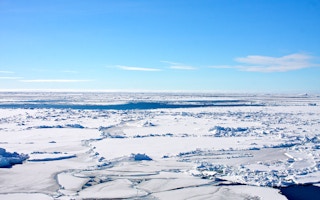Thanks to global heating, a vital part of the Southern Ocean is warming at a rate five times faster than the average for the Blue Planet as a whole, in the far Antarctic depths: 2000 metres or more below the surface of the Weddell Sea.
It is happening because at that depth the Weddell Sea has absorbed five times as much atmospheric heat − fuelled by greenhouse gas emissions from human fossil fuel combustion − as the average for the rest of the ocean. But what happens out of sight and far below the surface may not stay invisible. The Weddell Sea is where vast volumes of water circulate.
The fear is that such dramatic warming at depth could end up weakening a powerful current that encircles Antarctica, according to a new study in the Journal of Climate.
The evidence comes from 30 years of temperature and salinity samples, taken at the same spot and through the entire water column, with exquisite accuracy, by scientists aboard the German research icebreaker Polarstern.
“Our data shows a clear division in the water column of the Weddell Sea. While the water in the upper 700 metres has hardly warmed at all, in the deeper regions we’re seeing a consistent temperature rise of 0.0021 to 0.0024 degrees Celsius per year,” said Volker Strass, of the Alfred Wegener Institute in Bremerhaven in Germany.
“Since the ocean has roughly 1,000 times the heat capacity of the atmosphere, these numbers represent an enormous scale of heat absorption. By using the temperature rise to calculate the warming rate in watts per square metre, you can see that over the past 30 years, at depths of over 2,000 metres, the Weddell Sea has absorbed five times as much heat as the rest of the ocean on average.”
The global ocean is the great absorber of atmospheric shock. The deep blue sea has so far absorbed more than nine-tenths of the heat trapped by greenhouse gas emissions in the atmosphere.
The Weddell Sea begins at the extreme south of the Atlantic Ocean: it is roughly 10 times the size of Europe’s North Sea. Here tremendous volumes of water cool down. As sea ice forms on the surface the remaining waters become more salty, and because they have become colder, and denser, sink to the bottom, to spread at depth to drive deep sea flow into the oceans.
Ocean circulation risk
This act of overturning − the sinking of surface waters for thousands of metres into the Antarctic depths − is part of the machinery of ocean circulation that drives and modifies the world’s weather systems, and the climate.
The problem is that if the bottom waters are warming − and are therefore less dense − then this could weaken or stall the mechanism for ocean circulation. In the past 30 years the prevailing winds have shifted and intensified, and the flow speed of ocean water has increased to deliver more heat to the Weddell Sea with each decade.
Warming ocean waters have already been implicated in the loss of sea ice cover that normally slows the flow of Antarctica’s continental glaciers. And warming in the Arctic has already triggered worries about the future of the “Atlantic Conveyer,” that enormous circulation of water that distributes heat from the Equator to the Poles and keeps northern Europe much warmer than its latitudes would dictate.
“Our time series confirms the pivotal role of the Southern Ocean and especially the Weddell Sea in terms of storing heat in the depths of the world’s oceans,” said Dr Strass.
This story was published with permission from Climate News Network.

















